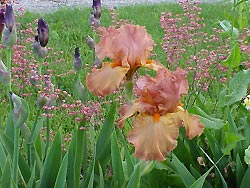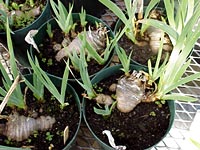
In the legends of the ancient Greeks, Iris -- goddess of the rainbow and a messenger of the gods -- shuttled between heaven and Earth atop colorful arcs. Wherever she stepped on earth, iris flowers sprang up in all the hues of the rainbow. To modern gardeners, these beloved flowers are, in a sense, gifts from the gods.
Of the many kinds of iris, the bearded ones, which are perfectly at home in cottage gardens and formal borders, are by far the most common.
While bearded iris are easy to grow in most regions, they show subtle preferences in climate and soil; these are worth knowing so you can enjoy them at their best. Also, because there are so many named varieties on the market, "Top Choices" (below) will help you select some of the best to grow in your garden.
As on all types of iris, the orchidlike flowers of bearded iris have six petals. The three inner ones that point up are called standards, and three outer ones that point down are called falls. The beards are the hairs that grow in the center of the falls. A healthy flowering stalk produces 9 to 12 buds on short side branches, and each flower lasts about three days over a total bloom time of about a month.
Iris are available in virtually every hue: sky blue to the deepest ocean blues, luxurious lavenders, regal purples, blazing coppers, radiant reds, saffron yellows, and soft to rosy pinks. Then there are the innumerable intricacies of color combinations, multihued beauties, contrasting beards, and other unique color patterns.
All bearded iris spread from rhizomes, roots that spread horizontally right at the soil's surface. The gray-green leaves are long, flat, and pointed, and they overlap almost like a fan.
Plants range in height from 4 inches to more than 36 inches, a habit that gives iris enthusiasts a convenient way to categorize them: dwarf (4 to 15 inches), intermediate (15 to 28 inches), and tall (more than 28 inches). The tall types, far and away the most popular, bloom in April in mild-winter regions, and as late as June in the north, but in most of the country their peak bloom is now, in May.
Most bearded iris bloom only once, but some newer introductions have the capacity to bloom a second (or third) time. Another way to maximize bloom is to use dwarf and intermediate types as well. They generally flower two to four weeks before the tall types.
Reblooming iris are extra-vigorous growers. They bloom in spring, earlier than normal, then again in summer, and, depending upon your climate, perhaps again in fall. Plants in coastal gardens can bloom continuously for 9 to 10 months, though 4 to 5 months of bloom is more typical. Most of these are tall types, while a few dwarf kinds also qualify as rebloomers.
 Where and How to Plant Bearded Iris
Where and How to Plant Bearded Iris
These flowers' popularity is explained in part by their being widely adaptable and easy to grow throughout most of North America. The only exception is the humid subtropics. For instance, they're fine from Bangor, Maine, to San Diego, California, but not in Houston, New Orleans, Miami, or Savannah. However, they do grow well a little farther north in the southeast (Shreveport, Birmingham, and Atlanta). Generally, iris grow in USDA Hardiness Zones 3 through 10 in the dry-summer West and in 3 through 8 in the rainy-summer East.
Most iris need at least 6 hours of full sun, and good drainage. In deeply cultivated, rich soil, they respond with superior growth and flowers. A soil pH near neutral is best. Sand or clay soils are okay, but you need to pay more attention to drainage in heavy clay soils. If water in your garden pools for more than half an hour after a rain, plant in raised beds or mounds.
In cool maritime regions like Seattle and Boston, day-long full sun is required, but in hot regions, such as Phoenix or Dallas, locate plants so they receive afternoon shade.
Set out plants anytime between midsummer and a month or so before first frost: July to October in most regions, July and August in coldest climates, and September and October in hottest climates. You have somewhat more latitude in transplanting container-grown iris as they suffer less stress in the process.
Whether you buy plants by mail or are the beneficiary of a generous neighbor, what you put into the ground looks the same: a 1/2-inch-thick, 2- to 3-inch-long fleshy rhizome with short, spaghetti-like roots spreading from its sides, and a short fan of leaves at one end. The rhizomes are tough enough to stay out of the ground for a week or two without serious harm, but the sooner they are planted, the better.
Amend the soil with generous amounts of compost or peat moss, and add 2 pounds of 5-10-10 fertilizer for every 100 square feet of garden. If your soil tends to be acidic, add ground dolomitic limestone to raise the pH to nearly neutral. (Use a soil test to determine your soil's pH and the type and amounts of amendments necessary.)
Space rhizomes 1 to 2 feet apart, or closer for a more immediate effect and for dwarf varieties. However, close planting usually means sooner replanting. Set each plant in a shallow hole large enough to accommodate the division and the attached fibrous roots. Because new plants will emerge from the fan end and sides of the rhizome, orient the leaf end in the direction you want to growth to take.
If you're planting several iris of the same variety, arrange them in drifts with the fans all pointing in the same direction, or plant in a circular clump with fans pointing outward.
Cover the rhizomes with only 1/2 inch of soil. Depth of planting is particularly important in heavy clay soils where drainage may be impeded. Water to settle the soil and start growth, then water sparingly until new growth indicates that roots are growing.
Plants need regular water throughout the growing season, but especially until six weeks after flowers fade. It's during this period that the next season's growth is initiated. Established clumps are drought tolerant and don't need water except in areas where there's little rainfall.
Lightly mulching new plantings is important. It prevents sunburn in the hottest regions. In the coldest regions, it prevents freezing and thawing of soil, which can kill the shallow-rooted plants.
Fertilizing and Long-Term Care
As growth begins in spring, apply low-nitrogen fertilizer around established plants. Compost or a low-nitrogen controlled-release fertilizer is ideal in spring, paired with a high-phosphorus fertilizer in fall. In the coldest climates (zones 3 through 5), don't fertilize after mid-July to give plants time to harden off before winter.
After blooms fade, cut flower stalks close to the ground, leaving healthy green leaves in place to nourish next year's growth. Remove dead leaves and debris in late autumn, then trim the foliage back by two-thirds after the leaves have died back.
In cold-winter regions, cut back the tops to about 6 inches after the first hard frost, and rake up any debris. After the soil freezes, mulch with 4 to 6 inches of loose compost or weed-free straw. Soon after the snow melts in spring, remove the top layer of mulch to allow air and sunlight to dry the surface. Wait a few days before removing the rest of the mulch, taking care to not to break the center sections of fans where flower buds are developing.
Dividing. Lift and divide the rhizomes every three to four years. Without division, both the quantity and quality of blooms will diminish. Do it after bloom in the optimum planting time for your area. Rhizomes are easy to pry up with a garden fork or shovel. Pull clumps apart, replanting the thickest, firmest rhizomes; these are usually the ones that have grown during the current season. Throw away the oldest, leafless rhizomes, usually at the clump's center. Trim leaves to about 6 inches long, then let all the cleaned and groomed rhizomes air-dry overnight. Before replanting, amend soil with lots of fresh compost or organic matter.
When plants don't bloom. Plants may not bloom for many reasons, and sometimes it's a combination of two or more. Most often the clumps are overcrowded. If bloom is increasingly sparse, it's time dig up, thin, and replant the rhizomes.
Another reason for poor bloom is nutrient-poor soil. Bearded iris have a remarkable ability to survive poor conditions, but they grow and bloom best in rich, well-drained soil. A thin mulch of compost is beneficial.
Other reasons for lack of bloom include inadequate sunlight and small or not yet established divisions. Recently planted divisions may not bloom their first year.
Pests. Iris borers are the most destructive pests. They are the larvae of moths that lay eggs in fall in dead flower stalks and debris. Eggs hatch early the following spring, and then, as tiny caterpillars, they bore through the leaves and eat their way down into the rhizome. As they feed, borers introduce bacteria that cause a soft rot that ultimately turns leaves brown and destroys the plants.
Control borers by first removing and disposing of infected rhizomes and leaves. Clean up dead leaves and debris after hard frost in fall to remove the eggs and reduce borer numbers the following year. Iris leaves are most susceptible to borers in spring when they are 5 to 6 inches tall. If you see any borer "mines," or tunnels, in the leaves, pinch them to kill the hidden larvae.
Top Choices of Bearded Iris
Given the thousands of named varieties of iris, choosing can be difficult. Start with varieties that have won the Dykes Memorial Medal, awarded by the American Iris Society only after rigorous standards are met. Another reliable source of variety recommendations is the annual popularity poll taken by the AIS in which all members of the society vote (www.irises.org).
Nursery insiders tell us that pink is popular this year. But blacks, dark purples, and blues are always popular, perhaps for some practical as well as aesthetic reasons: They tend to be more cold-hardy, vigorous, and disease resistant. Lighter-colored flowers -- peaches, pinks, oranges, and yellows -- aren't as tough.
Here are some of the most popular bearded iris, as determined by members of the AIS. They all bloom at midseason unless otherwise noted; those that rebloom are also noted. Asterisks at the end of the description indicate Dykes Medal winners.
Tall (usually 35 to 40 inches)
Intermediate (usually 18 to 24 inches)
Dwarf (usually 6 to 12 inches)
Photography by Suzanne DeJohn/National Gardening Association